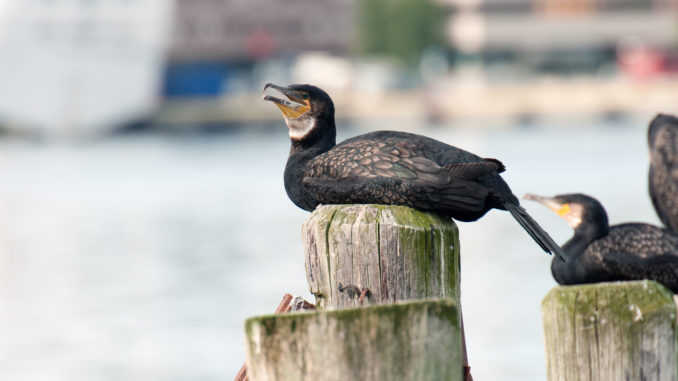
Feds will allow hunting of protected birds because of their negative effects on fish populations
The impact of an increasing population of double-crested cormorants on the forage base in the Santee Cooper lakes has become so severe that the S.C. Department of Natural Resources has announced a plan for a nearly 2-month hunting season on the birds after the close of duck season.
Citing a study by a Clemson University graduate student, SCDNR’s Derrell Shipes said it has been documented that the cormorants are eating threadfin shad, blueback herring and other forage fish that are the primary food sources for bass, striped bass and other gamefish in the Santee Cooper Lakes.
“We are trying to encourage the forage fish populations to feed the gamefish,” said Shipes, chief of statewide wildlife projects for SCDNR. “These birds are impacting both the forage fish that we are trying to pass into the Santee Cooper lakes through our fish lift and the fish that occur there naturally, and we feel that is impacting our ability to manage the fishery.”
While there is no evidence that cormorants are eating small bass and other gamefish in Lake Marion or Lake Moultrie, Shipes noted that studies done in northeastern states have shown that cormorants eat little smallmouth bass and yellow perch.
Cormorants are large birds, 24 to 34 inches long, with black feathers and a distinctive orange bank from the top of the bill around the eyes and under the neck. They swim in the water and dive under to chase fish.
The idea of a hunting season to try to reduce cormorant numbers on the lakes, especially during the winter when their population swells with migratory birds, has been applauded by fishermen and guides.
“Over the past 10 years or so, there have been a whole lot of migratory cormorants come into the lakes,” said Kevin Davis, a guide and co-owner of Black’s Camp. “Now we have a huge population of resident cormorants and a huge population of migratory cormorants.”
Davis said the aquatic birds not only impact the fishery by eating the forage fish, they also have a negative impact on the lakes’ environment.
“I’ve watched the places they roost, and whatever they roost on, their poop kills it. Their poop is really acidic and it is terrible for the places they roost,” Davis said.
The migratory cormorants begin showing up in the fall and stay on the lakes during the winter, Shipes said.
“It’s about time for them to arrive here now,” he added.
The study by a Clemson University graduate student in 2008 estimated the number of cormorants on the lakes at about 6,000, but locals believe that is an extremely low number.
“We’re getting a bigger migration each year, and now we’ve got more staying all year,” said retired guide Don Drose, who estimated there were at least 25,000 cormorants on the lakes at the migratory peak last winter.
“Unfortunately, part of the Clemson project was done during severe drought years, so we really don’t know what effect that had on the estimated population,” Shipes said. “We don’t know if the estimate was artificially high or artificially low because of the drought.”
But, he added, the population can definitely withstand some harvest.
“For some reason, and we don’t know how far back it goes, this population just took off,” he said.
Shipes hopes to reveal a finalized version of the cormorant hunting plan in about a week, he said.
The season will begin after the Federal Youth Hunting Day for waterfowl on Feb. 1, and will run through the rest of February and the month of March. Hunting hours will be one-half hour before official sunrise to sunset. Hunters will have to use shotguns with non-toxic shot, and there will be no limit on the number of birds taken. Hunters will be required to dispose of the birds by either burying them or by incineration.
Hunting will be limited only to those areas of the lakes where duck hunting is allowed, Shipes said.
Potential cormorant hunters will have to have a South Carolina hunting license, and they will have to attend an instructional session before receiving a permit. They will also have to report the number of birds they took after the season.
“We are planning two instructional seasons, both on Saturdays, in the (Santee Cooper) area,” Shipes said. “We plan to hold one session in January and one about a week after the season starts, because we think some people will hear about it and want to participate.”
The sessions, he said, will cover hunting rules, safety and cormorant identification.
“We’ve got some other birds that are aquatic that we do not want harvested, like anhingas, the federally endangered wood stork, loons, assorted wading birds and various others,” he said.
Although cormorants are federally protected under the Migratory Bird Treaty, SCDNR was able to obtain a depredation order from the U.S. Fish and Wildlife Service, Shipes said, because of growing evidence their numbers are impacting the lake’s fishery populations.
“This is legally sound, and we believe it is in the best interests of the fishery on the Santee Cooper Lakes,” Shipes said. “How effective it will be we don’t know, and we don’t know how many birds will be taken.”
But, if successful, he indicated that cormorant hunting could be expanded to other areas in the future.




Be the first to comment